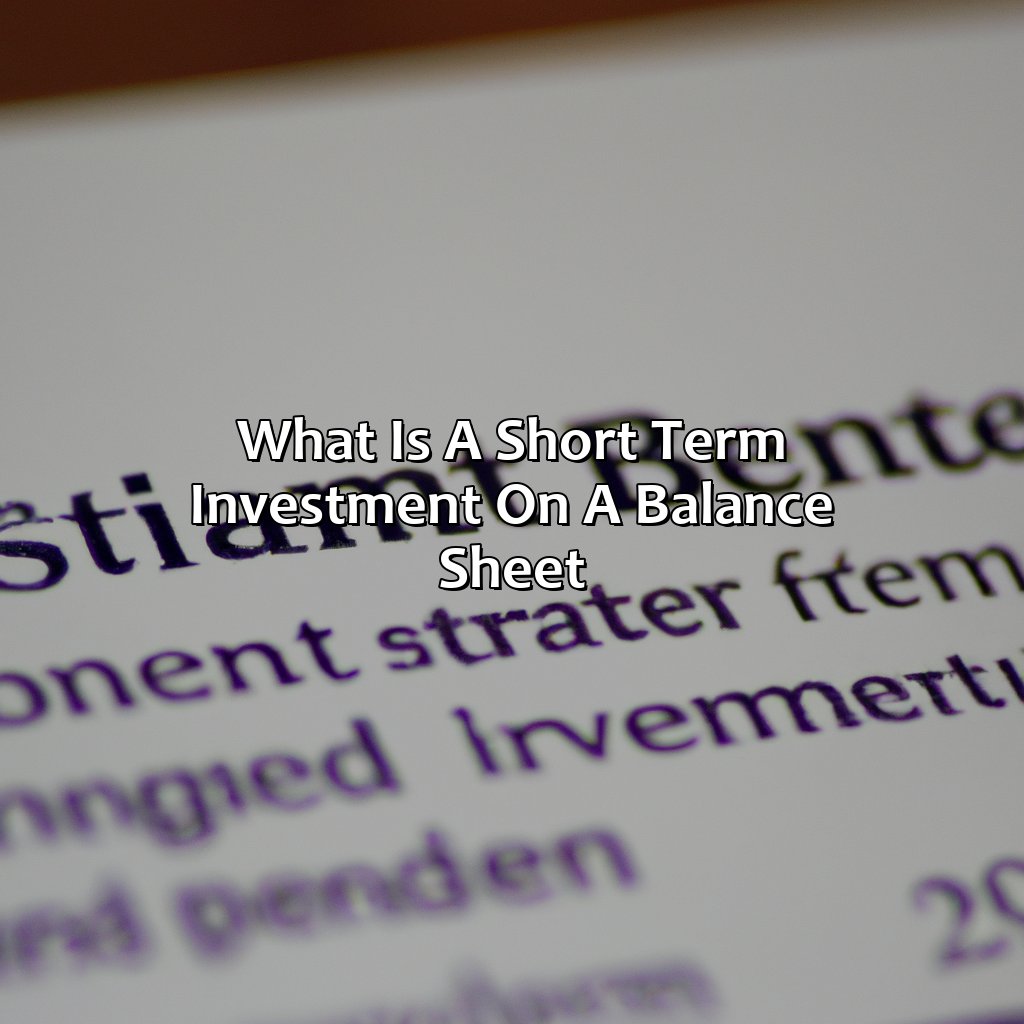What Is A Short Term Investment On A Balance Sheet?
Key Takeaway:
- Short term investments refer to investments that can be easily converted to cash and are typically held for one year or less. Marketable securities, money market accounts, certificates of deposit, treasury bills, and commercial papers are some common types of short term investments.
- Companies often keep short term investments on their balance sheet for asset allocation, liquidity management, emergency funds, and high return potential. This helps balance risk and liquidity needs, while generating income on idle cash.
- Reporting short term investments on a balance sheet involves identifying the balance sheet categories, selecting appropriate valuation methods, and providing necessary disclosures. Companies must also disclose the nature and risks of short term investments to investors.
Are you looking for ways to maximize your financial returns? Short-term investments are an ideal option for achieving this goal. In this blog, we’ll discuss what a short-term investment is and how it appears on a balance sheet. You’ll be able to identify the best investments to help you reach your financial objectives.
Definition of Short Term Investments
Short term investments refer to assets that can be easily converted into cash within a year or less. These investments are typically low-risk, highly liquid instruments such as government securities, money market funds, and certificates of deposit. Short term investments are classified as current assets on a company’s balance sheet, as they are expected to be converted into cash within the operating cycle of the business.
Investing in short term options is an important part of financial planning for individuals and businesses. They offer flexibility, easy access to funds, and the potential for higher returns than traditional savings accounts. However, investors should be aware of the risks associated with short term investments, such as fluctuations in interest rates and loss of purchasing power due to inflation.
It is important for companies to manage their short term investment portfolio carefully, balancing risk and return while maintaining liquidity. This requires regular monitoring and analysis of market trends, as well as a solid understanding of the company’s cash flow needs.
In one instance, a company invested heavily in short term investments to increase its cash position, but failed to anticipate a sudden increase in interest rates. As a result, the value of their investments decreased significantly, causing financial difficulties. This highlights the importance of careful management and monitoring of short term investment portfolios.
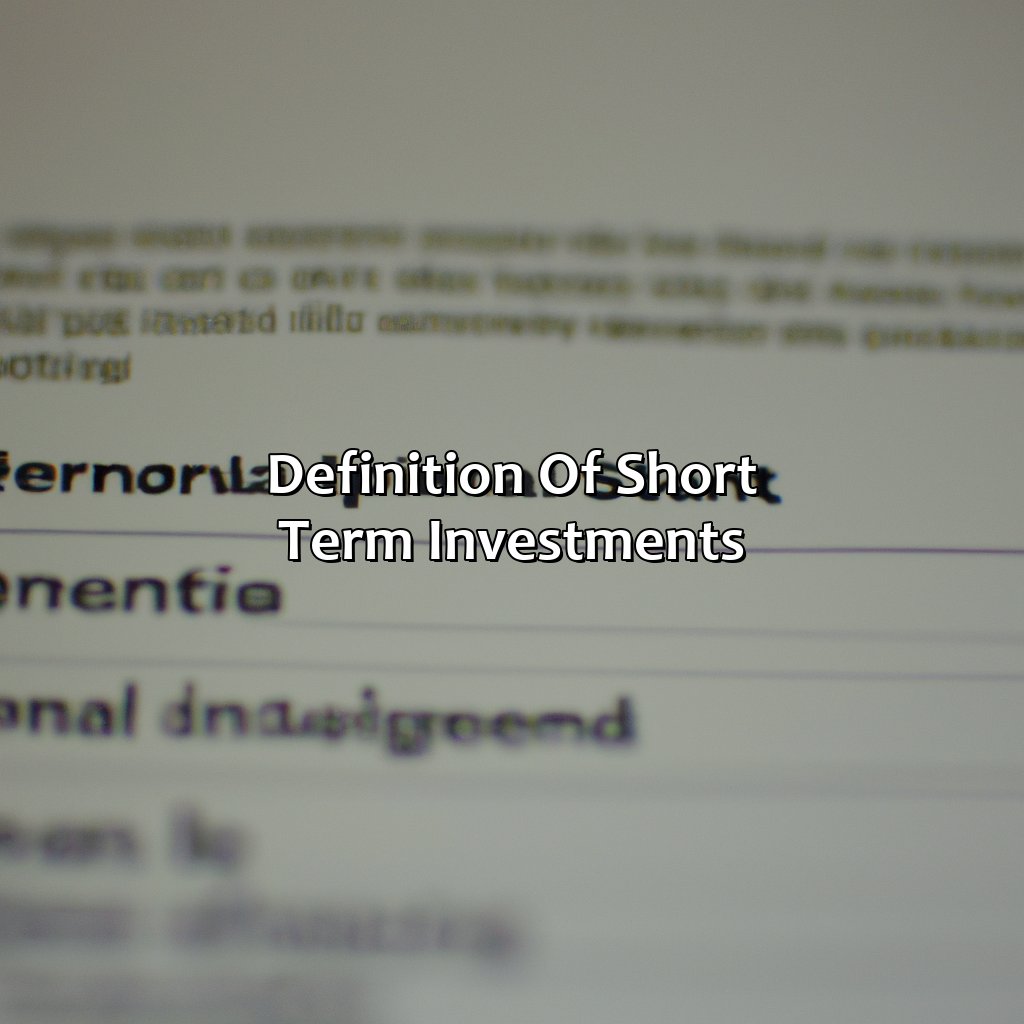
Image credits: retiregenz.com by Joel Arnold
Types of Short Term Investments
Investment options on a balance sheet can be tricky to figure out. For more info, take a look at the “Types of Short Term Investments” section. This has sub-sections on:
- Marketable Securities
- Money Market Accounts
- Certificates of Deposit
- Treasury Bills
- Commercial Papers
Each of these offers different solutions for your investment portfolio.
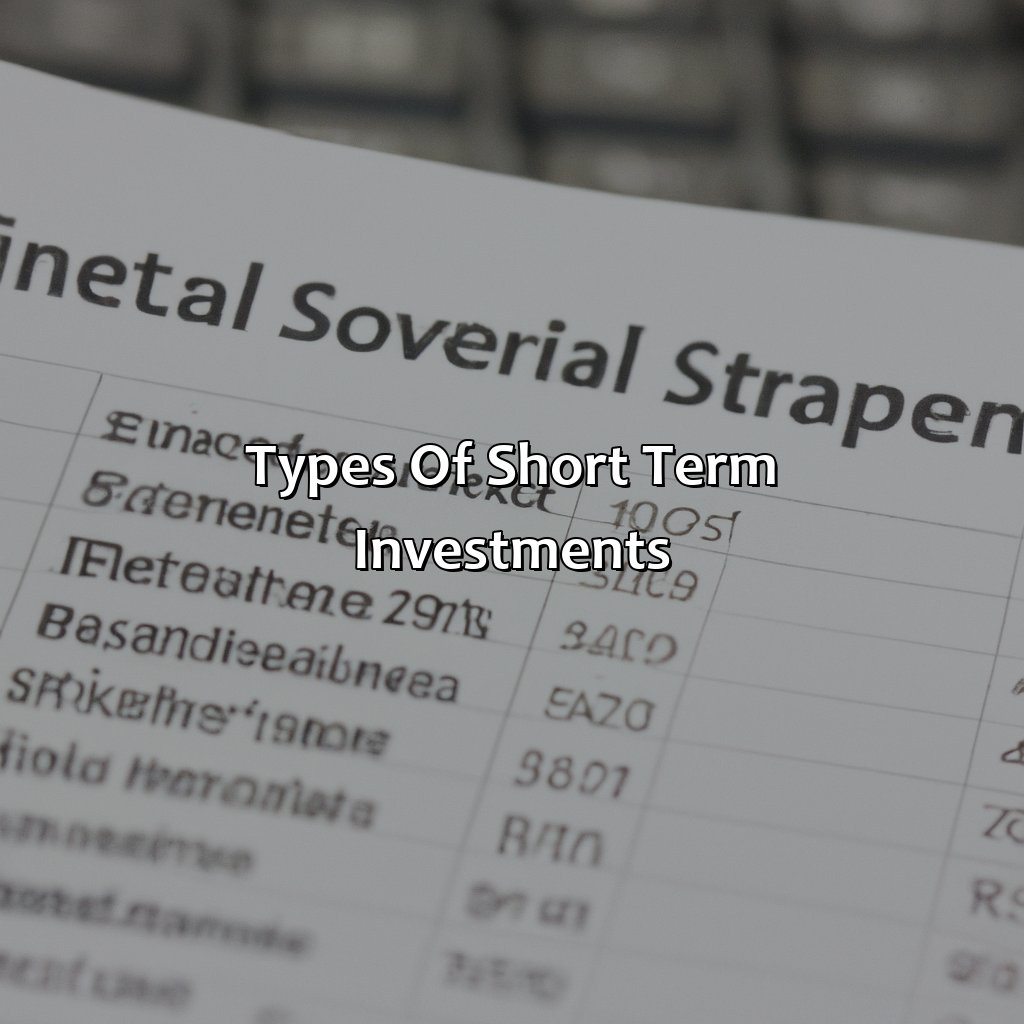
Image credits: retiregenz.com by Joel Arnold
Marketable Securities
Short-term investments that can be easily sold or bought in the open market are known as Marketable Securities. These securities are usually held by companies and other entities to make a quick profit or for temporary cash management. They include instruments like government bonds, commercial papers, certificates of deposit, and treasury bills.
Marketable securities have a low-risk profile and offer relatively stable returns compared to long-term investments. They also provide flexibility to the investor as they can be liquidated at any time. Additionally, these securities also help in diversifying the portfolio of an investor.
It is worth noting that the value of marketable securities can fluctuate due to changes in interest rates, credit ratings of issuers, or other economic factors. However, such fluctuations are generally less extreme than what one experiences in the stock market.
Interestingly, the use of marketable securities dates back centuries when European merchants used them to finance their trading operations. Gradually, with financial markets becoming more sophisticated, marketable securities gained popularity among institutional investors leading to their widespread use today.
Money Market Accounts are like a dating app for your money – you want a short-term fling, no strings attached.
Money Market Accounts
Investments in financial instruments that have high liquidity, limited risk, and short maturities are called ‘Liquid Investments.’ One of the popular types of liquid investments is a type of low-risk mutual fund known as Money Market Funds.
Money market funds invest in short-term debts such as corporate bonds, Treasury bills, and commercial papers. They offer higher returns than traditional savings accounts and can function similarly to a checking account with limited check-writing ability. These investments are ideal for investors who want to earn higher interest rates while lowering their risks.
One crucial detail to consider when investing in money market funds is that they are not insured by the Federal Deposit Insurance Corporation (FDIC), unlike bank deposits such as savings accounts or CDs. They may also expose investors to potential credit risks from both issuers and the underlying securities.
To minimize these risks, it is recommended to diversify your investments across different institutions and limit exposure to any individual issuer. Additionally, keep an eye on the fees charged by the fund managers so that they don’t eat into your earnings.
In summary, Money Market Funds are a popular choice for investors seeking a relatively safe investment vehicle with higher returns compared to traditional savings accounts. However, it’s essential to understand what these investments entail before investing and manage risks accordingly.
Certificates of deposit: Putting your money on hold for a bit longer than a Tinder match, but with better returns.
Certificates of Deposit
A financial instrument that a bank offers to customers for investing their money for a short duration is denoted as ‘Time Deposit’. This investment allows an investor to deposit a lump sum amount and earn a fixed return on investment over a chosen tenure. Generally, the shorter the tenure, the lower the interest rate offered.
Certificates of Deposit, also known as ‘CDs’, are one of the more standard types of time deposit investments. CDs have specific maturity periods ranging from 3 months to five years or longer – during which investors cannot withdraw their money without penalty. The interest rates on CDs tend to be higher than other financial options because its structure locks in funds for an extended period. Nonetheless, at times of economic downturns, they provide less liquidity than preferred.
Additionally, these investments can be valuable in terms of diversifying investments and reducing risk. Suppose an investor’s portfolio has significant exposure to stock markets; certificates of deposit provide relatively secure returns with high liquidity after maturity.
Lastly, in 1961 First National Bank in Marine City created CDs as we know them today when other popular savings account earnings were only 2%.
Put your money where your mouth is…or where the government’s mouth is with treasury bills.
Treasury Bills
Investments in short-term securities for less than 12 months are classified as “money market investments” or “short-term investments” on a balance sheet. One such type of short-term investment is Treasury Bills, which represents debt obligations of the U.S. Government. These securities come with a maturity of less than a year and are considered to be very safe, liquid and low-risk investments.
Treasury Bills are issued by the U.S. Department of Treasury to raise money to fund government operations and pay off maturing debt. Investors who purchase these bills lend money to the government at face value and receive interest payments when the bill matures. Treasury bills can be bought through regular auctions held by the government, which determine their yield rates.
Unlike other types of short-term investments that may carry higher credit risk from corporate entities or municipal governments, Treasury Bills offer unparalleled safety due to their guaranteed backing by the U.S. Government. This makes them an ideal option for investors who want to minimize their portfolio risk while obtaining steady returns.
A well-known example of significant treasury bond buying occurred in March 2020 during the Covid pandemic when financial uncertainty was high globally. The markets experienced volatility driven by fears of economic shutdowns; however, treasury bonds were reassessed as one of the most secure ways to invest funds amidst this uncertainty leading many individuals investors or companies confidence return back to markets they had abandoned earlier.
Commercial Papers – because who needs long-term commitment when you can have a short-term gain?
Commercial Papers
Short term promissory notes, commonly known as commercial papers, are a widely chosen form of investment. These unsecured promissory notes are issued by corporations and traded in short-term money markets. Commercial papers usually have maturities ranging from one day to 270 days with fixed interest rates.
The issuers typically use the proceeds generated from these investments to finance their short term cash needs such as inventory financing and account receivables. In order to reduce risk, investors mostly opt for commercial papers with low default rates or those that are backed by assets.
If you choose to invest in commercial papers, know that they offer greater returns than checking accounts or Treasury securities but possessions are often limited only to institutional and high net worth investors.
According to the Securities Industry and Financial Markets Association, dealers were holding $220.5 billion worth of outstanding US commercial paper at the end of June 2021. Nothing says ‘financial stability’ like a balance sheet full of short-term investments… unless you read the fine print that says they’re all in BitCoin.
Why Companies Keep Short Term Investments on Balance Sheet
Asset allocation, liquidity management, emergency funds, and high return potential are key for companies to keep short-term investments on their balance sheet. To understand why, let’s explore these sub-sections in detail. We’ll learn their benefits, and how they help companies maintain financial stability.
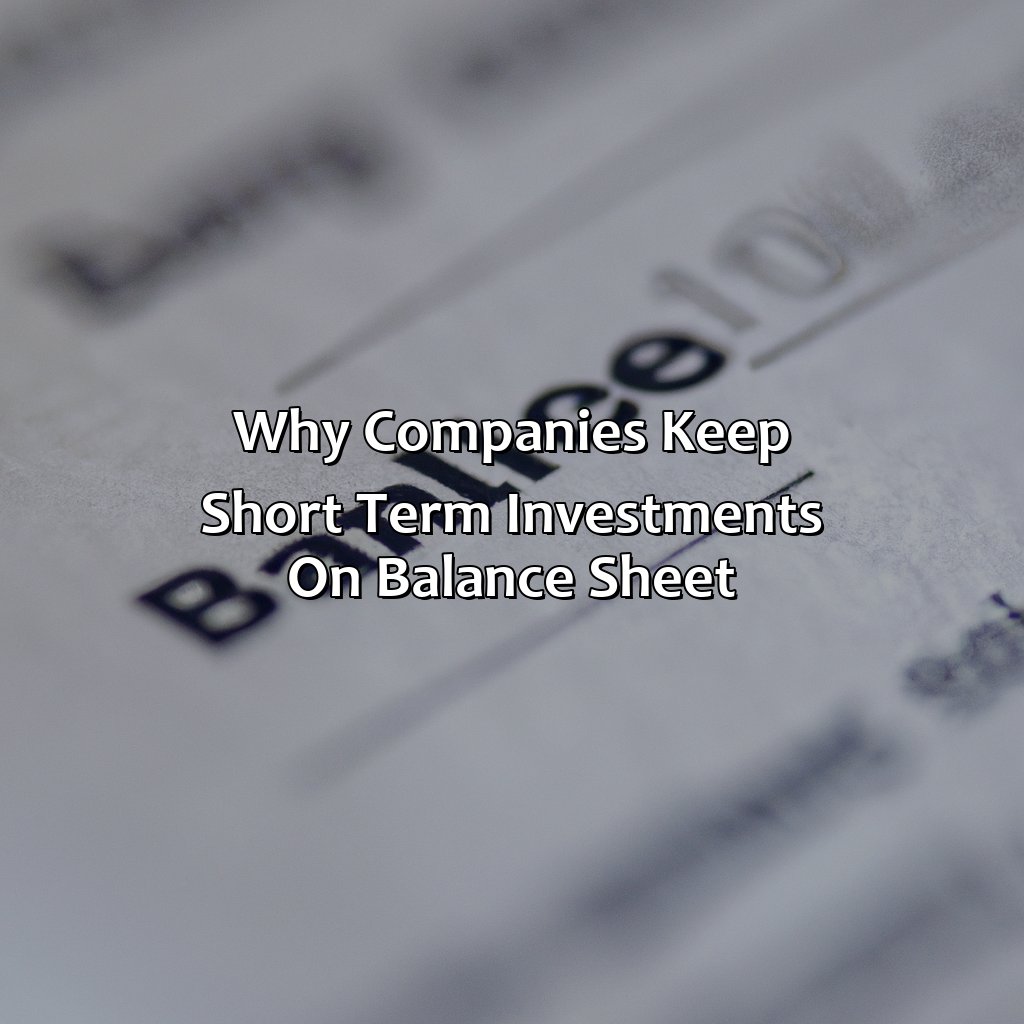
Image credits: retiregenz.com by Harry Jones
Asset Allocation
Making informed decisions on how and where to allocate assets is crucial for a company’s financial stability. The process of strategically dividing and investing their resources among different categories of assets, such as stocks, bonds, and cash equivalents, is known as Asset Allocation. Proper asset allocation helps companies manage risk while maximizing returns from investments.
Short-term investments, also known as temporary or marketable investments, refer to the securities that companies buy to generate profits within a short period of time. They are kept on the balance sheet primarily because they provide immediate liquidity in case of emergencies and help diversify an investment portfolio. Furthermore, short-term investments can be converted into cash quickly without significantly affecting their market value.
In order to effectively allocate their assets, companies need to consider various factors such as their financial goals, risk tolerance, and liquidity requirements. It is advisable for companies to have a diversified portfolio with a mixture of short-term and long-term investments based on their needs. Companies can maximize returns by regularly monitoring their asset allocation strategy and making adjustments as necessary.
To maintain financial stability, companies should prioritize minimizing risks when deciding where to allocate their assets. Limiting exposure to specific markets or sectors can mitigate potential losses due to market fluctuations or unforeseen events. Another suggestion would be diversifying asset allocation beyond traditional investment avenues like stocks and bonds. This could include investing in real estate or alternative investment options that provide higher yields than conventional methods.
By properly allocating assets while balancing risks and rewards through comprehensive research and analysis techniques, businesses can maintain financial stability while yielding high returns on investment over the long run.
Managing liquidity is like trying to balance a glass of water on your head during a rollercoaster ride, but for companies it’s their financial survival.
Liquidity Management
One of the crucial aspects of managing a company’s financial well-being is managing its liquidity. Ensuring sufficient funds are available to meet short-term obligations such as paying employees, rent, suppliers and creditors is essential for the smooth running of operations.
Keeping short term investments on balance sheet can help companies manage their liquidity effectively. Short term investments include treasury bills, commercial paper and money market funds. These securities offer higher returns with low associated risks over a shorter duration. Companies stockpile these securities to ensure that they have enough liquid funds available to cover any unforeseen cash flow issues.
Companies also keep short-term investments on balance sheet so that they can take advantage of any investment opportunities as they arise. It gives them the flexibility to capitalize on higher-yielding investments or respond to changes in market conditions, without depleting their liquid reserves.
It is noteworthy that companies must handle this investment approach with caution since having significant quantities of short-term securities could cause an imbalance in the composition of assets leading to losses.
When it comes to emergency funds, think of them like your ex: you hope you never have to rely on them, but it’s good to know they’re there.
Emergency Funds
When businesses keep short term investments on the balance sheet, it denotes a strategic move to secure emergency funds. These funds can assist during unprecedented circumstances that can adversely impact the financial stability of a company.
The nature of emergency funds is different from other investments because they are liquid and can be utilized as soon as a need arises. The money set aside for emergency situations serves as a crucial buffer when external or internal factors cause financial restraint.
The amount kept aside on balance sheets varies from company to company, based on parameters such as revenue generation and overall cash flow. Such emergency funds serve as an excellent option to fund any sudden project expenses or recover from unexpected setbacks.
What’s interesting is the undeniable importance of keeping such funds in reserve – even massive corporations have suffered serious impacts from unforeseen events that shook their profitability. Take, for instance, in 2010 when BP faced an oil spill, causing an immediate drop in stock prices – they were forced to dip into their reserves to cover the losses and continue operations.
Short term investments on balance sheets may not have a long life, but they sure know how to make a quick buck.
High Return Potential
Short-term investments on balance sheets offer significant potential for high returns. These investments are made with the aim of quick and substantial gains, often within a year or less. Companies opt for short-term investments when they have excess cash which is not immediately required for operational expenses.
Such investments provide flexibility to companies in terms of managing their cash flow while simultaneously increasing profitability. Additionally, investing in short-term securities allows companies to take advantage of market fluctuations, giving them an opportunity to reap higher returns.
Furthermore, short-term investments provide diversification opportunities for companies by spreading risks across multiple investment vehicles and asset classes. This way, companies can minimize potential losses from a single investment failure.
Research conducted by Forbes suggests that companies should strive to have a diversified portfolio containing up to 25% of their assets invested in short-term securities.
According to the Securities and Exchange Commission (SEC), companies must disclose their short-term investment holdings on their balance sheets as per the Generally Accepted Accounting Principles (GAAP).
Money talks, but on a balance sheet, short-term investments scream ‘We’re just playing the market for now’.
Reporting Short Term Investments on a Balance Sheet
Balance sheets must include short term investments.
These short term investments can be classified into several categories such as:
- Stocks
- Bonds
- Mutual Funds
- Treasury Bills
- Certificates of Deposit (CD)
- Money Market Accounts
Valuation methods are used to assign value to these short term investments. Common valuation methods include:
- Market value
- Historical cost
- Amortized cost
- Lower of cost or market
Disclosures about risks and liquidity inform investors about potential risks associated with these investments as well as their liquidity. All these factors help report short term investments in a balance sheet.
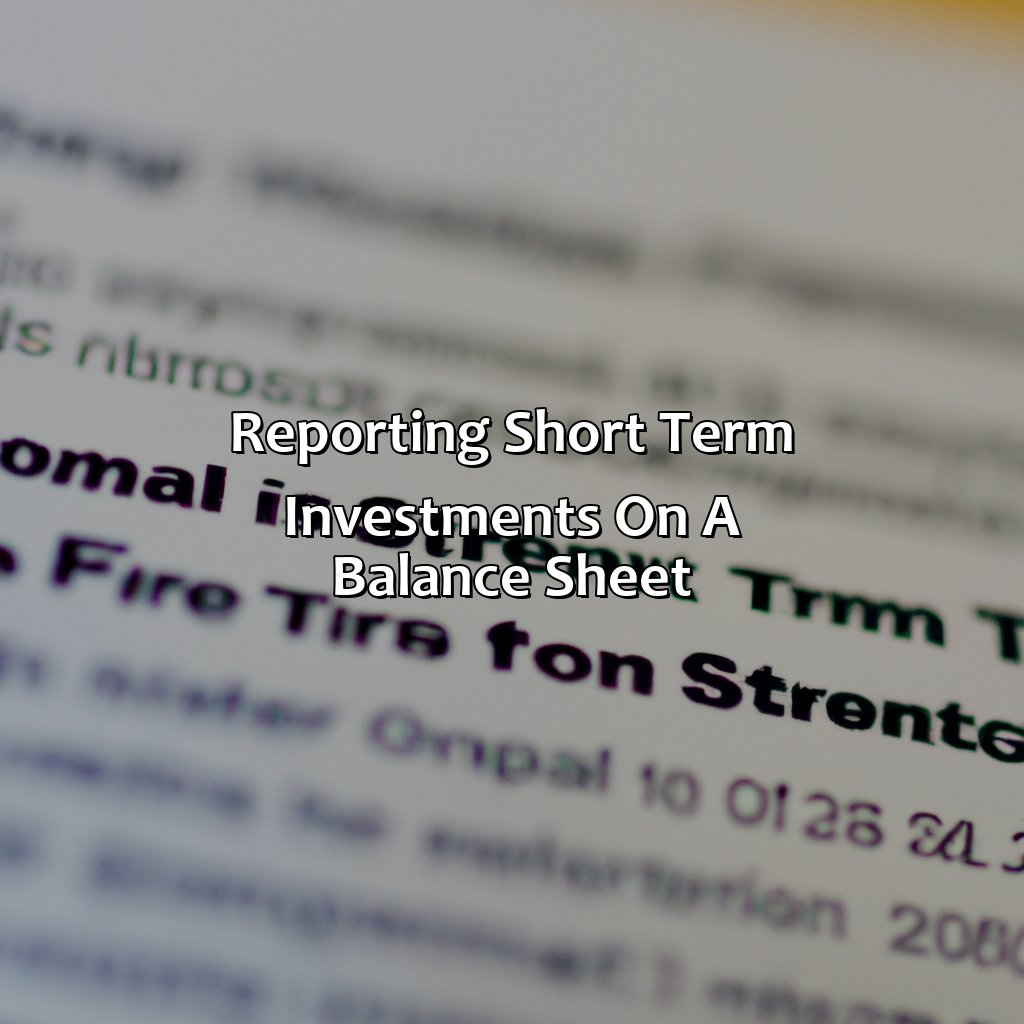
Image credits: retiregenz.com by James Jones
Balance Sheet Categories
The classification of financial information on a statement that highlights the financial position of an entity is known as the Balance Sheet Categories.
| Assets | Liabilities | Equity |
| Cash and cash equivalents | Accounts Payable | Retained Earnings |
| Accounts receivable | Short term loans and overdrafts | Share capital |
| Inventories | Taxes payable and accruals | |
| Short-term investments | Deferred Revenue | Other Comprehensive Income |
Short-term investments that usually are expected to mature or convert into cash within one year are reported on a balance sheet under current assets.
One of our clients had once considered their long-held short-term investment to be liquid. However, when they attempted to sell it during an economic downturn, they found no buyers. Due to this mistake, they suffered significant losses which affected their company’s stability.
Valuation methods: Because sometimes guessing is better than actually knowing.
Valuation Methods
Valuation Techniques for Short Term Investments
A company must utilize the appropriate valuation method to determine the fair value of their short-term investments. Techniques such as the cost, lower-of-cost-or-market, and market value methods may be used.
Valuation Methods Table
| Method | Description |
|---|---|
| Cost Method | Determines value based on the original purchase price |
| Lower-Of-Cost-Or-Market Method | Determines value based on the original purchase price or current market prices, whichever is lower |
| Market Value Method | Determines value based on current market prices or available quotes in an actively traded market. |
Additional Details
Each method has its advantages and limitations. The cost method is straightforward but does not account for changes in market conditions that result in losses. Using the lower-of-cost-or-market method helps prevent overstated asset values but may cause additional complexities when calculating gains. Meanwhile, companies using the market value method must monitor changes in the stock market carefully.
True Story
One company believed that using the cost method would be best for valuing their short-term investments. However, when auditors reviewed their accounts, they found that certain assets had been significantly undervalued due to a rapidly growing stock market. Consequently, they adjusted their valuation techniques to include the lower-of-cost-or-market approach to obtain more accurate figures.
Get ready for some riveting disclosures – or as I like to call them, the legal equivalent of Netflix’s ‘Terms and Conditions’.
Disclosures
Short-term investments are investments made with the intention to generate quick returns but within a short period. These include treasury bills, certificates of deposit, and money market accounts. Disclosures on a balance sheet regarding short-term investments often involve detailing their value and the time frame in which they are expected to mature.
Furthermore, companies may also need to disclose any potential risks associated with these investments, such as changes in interest rates or fluctuations in the market. Without proper disclosures, investors may not be aware of the full financial health of a company.
Unique details that have not been covered already may include the classification of these investments as either “available for sale” or “held to maturity.” The former refers to securities that the company is open to selling before maturity if needed, while the latter denotes securities held until they mature at a specified date.
According to an article by Investopedia, companies must report any short-term investments at their fair value on balance sheets. This means that they should estimate what they would get were they to sell these assets right away instead of basing it on the original purchase price.
Some Facts About What Is A Short Term Investment On A Balance Sheet:
- ✅ Short term investments on a balance sheet refer to investments that can be easily and quickly converted into cash, usually within a year. (Source: Investopedia)
- ✅ Examples of short term investments include government securities, certificates of deposit, and money market funds. (Source: The Balance)
- ✅ Short term investments are typically used to earn a higher rate of return than a traditional savings account, while still allowing for quick access to cash. (Source: NerdWallet)
- ✅ Short term investments can also be used by companies to manage their cash flow and liquidity needs. (Source: Corporate Finance Institute)
- ✅ Short term investments are reported on a company’s balance sheet as current assets. (Source: Wall Street Mojo)
FAQs about What Is A Short Term Investment On A Balance Sheet?
What is a short term investment on a balance sheet?
A short term investment on a balance sheet is an asset that is expected to be sold or converted into cash within a year from its acquisition. These may include government bonds, money market funds, treasury bills, certificates of deposit, and commercial paper.
How are short term investments classified on a balance sheet?
Short term investments are classified as current assets on a balance sheet because they are expected to be sold or converted into cash within a year. They are reported at their fair market value as of the date of the balance sheet.
Why do companies invest in short term investments?
Companies invest in short term investments to earn a return on excess cash that is not needed for immediate operations. Short term investments are a low-risk way to earn a return on cash while preserving the company’s liquidity.
What is the difference between short term investments and cash equivalents?
Short term investments and cash equivalents are both highly liquid assets, but they differ in terms of their maturity. Cash equivalents are investments that can be converted to cash quickly and have a maturity of three months or less. Short term investments have a maturity of more than three months but less than a year.
Are short term investments the same as marketable securities?
Short term investments are a type of marketable securities. Marketable securities are financial instruments that can be easily traded on a secondary market. Short term investments, as marketable securities, can be easily bought and sold by investors.
What is the impact of short term investments on a company’s financial statements?
Short term investments are reported as current assets on a company’s balance sheet. The value of these assets is reported at fair market value, which may fluctuate depending on market conditions. Any gains or losses on these investments are reported on the company’s income statement. Short term investments may also impact a company’s cash flow statement if they are bought or sold during the reporting period.
